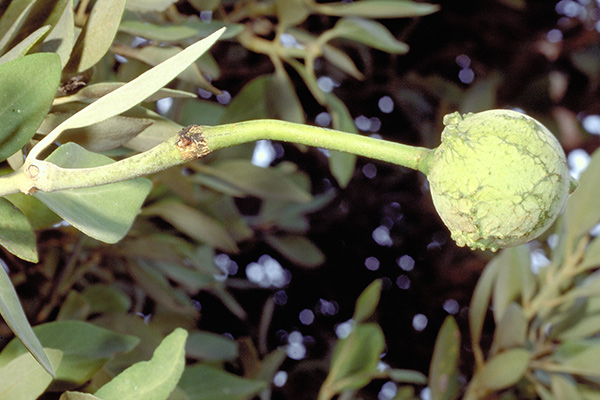
Wild Orange - Capparis mitchellii
Jan Sked
Capparis mitchellii is also known as Native Pomegranate and Bumble Tree. It was named after the explorer, Major Mitchell, who was the first white man to see the tree. According to Mitchell, the fruit had an agreeable perfume. Aboriginal people ate the raw fruit which is a good source of vitamin C and thiamine.
It is a tall shrub or small rounded tree, 5-8 metres in height, with a dense crown and black, deeply fissured bark. Young plants are straggly and very thorny, but older plants become more erect and have fewer thorns. Dull green, oval, rigid leaves, 2-6cm x l-3cm, clothe the woolly, spiny branches.
Flowers can be found at any time of the year. They are beautiful, large white or creamy- yellow blossoms with long protruding stamens. Each flowers only lasts for a day. The fruits that follow are rounded and green and hang from the branches on long curved stalks. When ripe they are purplish or dull orange, soft to the touch, sweet smelling, and generally about 4- 7cm across. The pulpy yellowish flesh is the part to eat. It is quite tasty, although a bit astringent.
 |
| Immature fruit of Capparis mitchellii |
The seeds are peppery and should be removed from the flesh. The skin is bitter and inedible. Fruit can be eaten raw or used in desserts (eg. ice cream, gelato, mousse, etc.) and cordials. Can also be added to savoury dishes like casseroles, curries, rice and couscous. The best time for fruit tends to be mid to late summer.
Wild Orange occurs naturally in the drier parts of inland Australia in open savannah forest and grassland, generally on heavier textured soils. It is suitable to grow in drier areas and will tolerate a range of soils including limestone. However, it will not tolerate bad drainage. It is slow growing. Full sun is preferred. Plants are drought and frost tolerant.
Propagation is from seed or cuttings of firm wood.
C. mitchellii is a host plant for the Caper White Butterfly, the larvae of which can seriously defoliate it. Birds also relish the fruit.
From the newsletter of the Society for Growing Australian Plants (Queensland Region), September 2008.
Australian Plants online - 2009
Australian Native Plants Society (Australia)
|